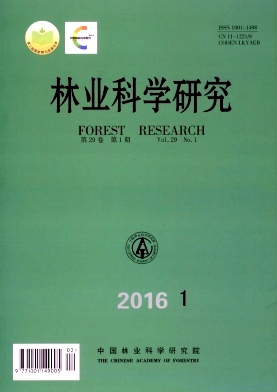|
[1]
|
丁圣彦, 宋永昌. 常绿阔叶林植被动态研究进展[J]. 生态学报, 2004, 24(8): 1769-1779.
|
|
[2]
|
宋永昌, 陈小勇, 王希华. 中国常绿阔叶林研究的回顾与展望[J]. 华东师范大学学报: 自然科学版, 2005, 1(1): 1-8.
|
|
[3]
|
Wang X H, Kent M, Fang X F. Evergreen broad-leaved forest in Eastern China: its ecology and conservation and the importance of resprouting in forest restoration[J]. Forest Ecology and Management, 2007, 245(1): 76-87. |
|
[4]
|
宋永昌, 中国常绿阔叶林:分类·生态·保育[M]. 北京:科学出版社, 2013, 11
|
|
[5]
|
陈小勇, 陈 波, 蒋屹峰. 片断化对常绿阔叶林种类组成的影响[J]. 华东师范大学学报 (自然科学版), 2003, 3: 69-74.
|
|
[6]
|
杨永川, 袁兴中, 李百战, 等. 重庆都市区残存常绿阔叶林的群落特征及其意义[J]. 生物多样性, 2007, 15(3): 247-256.
|
|
[7]
|
达良俊, 宋 坤. 浙江天童受损常绿阔叶林实验生态学研究(Ⅰ):生态恢复实验与长期定位[J]. 华东师范大学学报 (自然科学版), 2008(4): 1-11.
|
|
[8]
|
王凤友. 森林凋落物量综述研究[J]. 生态系统学进展, 1989, 6(2): 95-102.
|
|
[9]
|
Armson K A. Forest, Soils: Properties and Processes[M]. Toronto, Buffalo: University of Toronto Press, 1977. |
|
[10]
|
Maguire D A. Branch mortality and potential litterfall from Douglas-fir trees in stands of varying density[J]. Forest Ecology & Management, 1994, 70(1-3): 41-53. |
|
[11]
|
Loranger G, Ponge J F, Imbert D, et al. Leaf decomposition in two semi-evergreen tropical forests: influence of litter quality[J]. Biology & Fertility of Soils, 2002, 35(4): 247-252. |
|
[12]
|
LIUChun-jiang, Hannullvesniemi, BjomBerg, et al. Aboveground litterfall in Eurasian forests[J]. 林业研究:英文版, 2003, 14(1): 27-34.
|
|
[13]
|
Waring R H, Schlesinger W H. Forest Ecosystems: Concepts and Management[J]. New York: Academic Press, 1985: 115-160. |
|
[14]
|
Xiong S, Nilsson C. The effects of plant litter on vegetation: a meta-analysis[J]. Journal of Ecology, 1999, 87(6): 984-994. |
|
[15]
|
Bray J R. Litter production in forests of the world[J]. Advances in Ecological Research, 1964, 2: 101-157. |
|
[16]
|
Clark D A, Brown S, Kichlighter W K, Charmbers J Q, Thomlinson J R, Ni J, Holland E A. Net primary production in tropical forests: an evaluation and synthesis of existing field data[J]. Ecological Applications, 2001, 11(2): 371-384. |
|
[17]
|
Sundarapandian S M, Swamy P S. Litter production and leaf-litter decomposition of selected tree species in tropical forests at Kodayar in the Western Ghats, India[J]. Forest Ecology and Management, 1999, 123(2): 231-244. |
|
[18]
|
Gartner T B, Cardon Z G. Decomposition dynamics in mixed-species leaf litter[J]. Oikos, 2004, 104(2): 230-246. |
|
[19]
|
Li Z A, Zou B, Xia H, et al. Litterfall dynamics of an evergreen broadleaf forest and a pine forest in the subtropical region of China[J]. Forest Science, 2005, 51(6): 608-615. |
|
[20]
|
张 磊, 王晓荷, 米湘成, 等. 古田山常绿阔叶林凋落量时间动态及冰雪灾害的影响[J]. 生物多样性, 2011, 19(02): 206-214.
|
|
[21]
|
刘文飞, 樊后保, 高春芬, 等. 连续年龄序列桉树人工林凋落物量及养分通量[J]. 生态学杂志, 2009, 28(10): 1928-1934.
|
|
[22]
|
李洁冰, 闫文德, 马秀红. 亚热带樟树林凋落物量及其养分动态特征[J]. 中南林业科技大学学报, 2011, 31(5): 223-228.
|
|
[23]
|
宋吉红, 张洪江, 姜广翔. 缙云山自然保护区4种森林类型林地土壤的持水特性研究[J]. 西部林业科学, 2008, 36(4): 26-33.
|
|
[24]
|
Ohsawa M , Wildpret W and Acro M D. A comparative study on evergreen broad-leaved forests and trees of the Canary Islands and Japan[M]. Laboratory of Ecology , Chiba University, 1999, 67-87. |
|
[25]
|
Ohsawa M. Differentiation of vegetation zones and species strategies in the subalpine region of Mt. Fuji[J]. Vegetatio, 1984, 57(1): 15-52. |
|
[26]
|
杨永川, 达良俊, 陈 波. 天童米槠-木荷群落主要树种的结构及空间格局[J]. 生态学报, 2006, 26(9):2927-2938.
|
|
[27]
|
官丽莉, 周国逸, 张德强, 等. 鼎湖山南亚热带常绿阔叶林凋落物量20年动态研究[J]. 植物生态学报, 2004, 28(4): 449-456.
|
|
[28]
|
宁晓波, 项文化, 王光军, 等. 湖南会同连作杉木林凋落物量20年动态特征[J]. 生态学报, 2009, 29(9): 5122-5129.
|
|
[29]
|
王健健, 王永吉, 来利明, 等. 我国中东部不同气候带成熟林凋落物生产和分解及其与环境因子的关系[J]. 生态学报, 2013, 33(15): 4818-4825.
|
|
[30]
|
张新平, 王襄平, 朱 彪, 等. 我国东北主要森林类型的凋落物产量及其影响因素[J]. 植物生态学报, 2008, 32(5): 1031-1040.
|
|
[31]
|
郑 征, 刘伦辉, 和爱军, 等. 西双版纳湿性季节雨林凋落物和叶虫食量研究[J]. 植物学报, 1990, 32(7): 551-557.
|
|
[32]
|
卢俊培, 刘其汉. 海南岛尖峰岭热带林凋落物研究初报[J]. 植物生态学与地植物学学报, 1988, 12(2): 104-112.
|
|
[33]
|
罗 辑, 程根伟, 陈斌如, 等. 贡嘎山垂直带林分凋落物及其理化特征[J]. 山地学报, 2003, 21(3): 287-292.
|
|
[34]
|
于明坚, 陈启嫦, 李铭红, 等. 浙江建德青冈常绿阔叶林凋落量研究[J]. 植物生态学报, 1996, 20(2): 144-150.
|
|
[35]
|
王樟华. 浙江天童常绿阔叶林凋落物量的时空分布特征[D]. 华东师范大学, 2013
|
|
[36]
|
胡灵芝, 陈德良, 朱慧玲, 等. 百山祖常绿阔叶林凋落物凋落节律及组成[J]. 浙江大学学报(农业与生命科学版), 2011, 37(5): 533- 539.
|
|
[37]
|
陈 波, 达良俊, 宋永昌. 常绿阔叶树种栲树开花物候动态及花的空间配置[J]. 植物生态学报, 2003, 27(2): 249-255.
|
|
[38]
|
Liu C, Westman C J, Berg B, et al. Variation in litterfall-climate relationships between coniferous and broadleaf forests in Eurasia[J]. Global Ecology and Biogeography, 2004, 13(2): 105-114. |
|
[39]
|
Lawrence D. Regional-scale variation in litter production and seasonality in tropical dry forests of southern Mexico[J]. Biotropica, 2005, 37: 561-570. |
|
[40]
|
Polyakova O, Billor N. Impact of deciduous tree species on litterfall quality, decomposition rates and nutrient circulation in pine stands[J]. Forest Ecology and Management, 2007, 253: 11-18. |
|
[41]
|
Scherer-Lorenzen M, Luis Bonilla J, Potvin C. Tree species richness affects litter production and decomposition rates in a tropical biodiversity experiment[J]. Oikos, 2007, 116(12): 2108-2124. |
|
[42]
|
Wieder R K, Wright S J. Tropical forest litter dynamics and dry season irrigation on Barro Colorado Island, Panama[J]. Ecology, 1995: 1971-1979. |
|
[43]
|
Schessl M, Da Silva W L, Gottsberger G. Effects of fragmentation on forest structure and litter dynamics in Atlantic rainforest in Pernambuco, Brazil[J]. Flora-Morphology, Distribution, Functional Ecology of Plants, 2008, 203(3): 215-228. |
|
[44]
|
徐文铎, 陈 玮, 何兴元, 等. 沈阳城市森林凋落物数量及动态[J]. 应用生态学报, 2012, 23(11): 2931-2939.
|
|
[45]
|
Wafar S, Untawale A G, Wafar M. Litter fall and energy flux in a mangrove ecosystem[J]. Estuarine, Coastal and Shelf Science, 1997, 44(1): 111-124. |
|
[46]
|
木村允. 陆地植物群落的生产量测定法[M]. 科学出版社, 1981.
|
|
[47]
|
王樟华, 王希华, 沈国春. 台风干扰对天童常绿阔叶林凋落物量的影响[J]. 华东师范大学学报(自然科学版), 2014, 1: 79-89.
|
|
[48]
|
范春楠, 郭忠玲, 郑金萍,等. 磨盘山天然次生林凋落物数量及动态[J]. 生态学报, 2014, 34(3): 633-641.
|
|
[49]
|
原作强, 李步杭, 白雪娇,等. 长白山阔叶红松林凋落物组成及其季节动态[J]. 应用生态学报, 2010, 21(9): 2171-2178.
|





 DownLoad:
DownLoad: